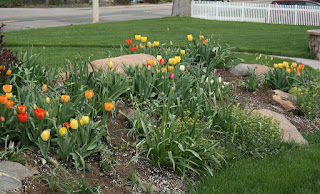While tulips are the mainstays of the flowering garden in
April and May, there is a group of bulbs that bloom much earlier in
the season. Planting these bulbs now will extend the bloom season in your
landscape from late winter into early spring. These bulbs are perfect for planting in groups
as well as mixing and matching and will provide a welcome sight in early
spring, often blooming through the snow.
Brightly colored crocus blooms are followed in succession by dwarf iris, grape hyacinths, regular hyacinths, and early daffodils.
Crocuses are the first of the bulbs to bloom, adding bright, bold color to the very early spring landscape. Crocuses prefer direct sun and thrive in sites that get at least 6–8 hours a day. They offer support for early foragers.
Muscari, known as grape hyacinths, are hardy spring bloomers
that produce blue or purple flowers that look like bunches of grapes, hence the
common name. They will do well in sun or semi-shade and over time will spread
naturally.
As an accent bloom, petite dwarf iris will add low-growing
color to the front of a border planting. Iris Reticulata, Sapphire Beauty and
Katherine Hodgkin are just a few of the miniature or dwarf iris available to
plant now.
Available in a variety of colors, regular hyacinths bring
height as well as fragrance to the early garden. Plant them in full sun to
partial shade.
Early blooming daffodils such as Rip van Winkle offer their
own distinct color and form, making them a popular choice for early spring
blooms.
All of these bulbs are
hardy in our gardening zone, meaning they will survive our winters and bloom
season after season, with just a little care.
Regardless of the variety of bulbs you choose, all
bulbs will do best when planted in well-amended soil, in a sunny spot in the
garden. In our area, well-amended soils are achieved when locally produced,
organic products are added to the existing soil.
Once the soil is prepared, dig in some Dutch Bulb Food. Added
at planting time, this fertilizer will improve rooting and bulb growth. When it
comes to planting, a good rule of thumb is to plant bulbs to a depth of three
times their height.
A one-inch crocus bulb should be buried flat side down, three
inches deep, as measured from the shoulder. You can vary the bloom time by the
depth you plant each bulb. Shallow planted bulbs will bloom earlier; deeper
bulbs will bloom later in the season. The risk with planting too shallow is the
bulb may not survive the winter. Another trick to control bloom time is to add
two or three inches of mulch to the bed. This will keep the ground cold and
slow bloom time.
For
best effect, early bulbs should be planted in clusters, not lined out in
rows. Check on your bulbs through the winter. They should be watered
every four to five weeks, along with the rest of the trees and shrubs in your
landscape.
Bulbs planted now will produce blooms
the first year, helping bridge the gap between winter
and traditional spring-blooming bulbs such as daffodils and
tulips.
If
you have questions regarding selecting and planting bulbs, stop in the store.
We'll be glad to help you.


























